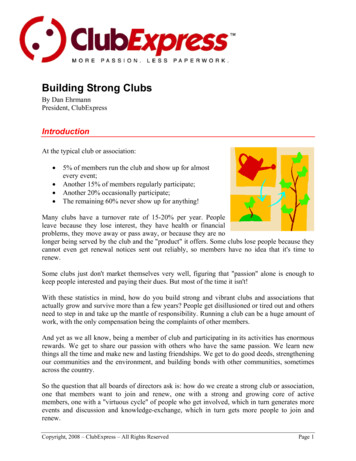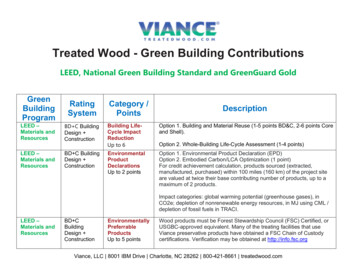
Transcription
Building Strong ClubsBy Dan EhrmannPresident, ClubExpressIntroductionAt the typical club or association: 5% of members run the club and show up for almostevery event;Another 15% of members regularly participate;Another 20% occasionally participate;The remaining 60% never show up for anything!Many clubs have a turnover rate of 15-20% per year. Peopleleave because they lose interest, they have health or financialproblems, they move away or pass away, or because they are nolonger being served by the club and the "product" it offers. Some clubs lose people because theycannot even get renewal notices sent out reliably, so members have no idea that it's time torenew.Some clubs just don't market themselves very well, figuring that "passion" alone is enough tokeep people interested and paying their dues. But most of the time it isn't!With these statistics in mind, how do you build strong and vibrant clubs and associations thatactually grow and survive more than a few years? People get disillusioned or tired out and othersneed to step in and take up the mantle of responsibility. Running a club can be a huge amount ofwork, with the only compensation being the complaints of other members.And yet as we all know, being a member of club and participating in its activities has enormousrewards. We get to share our passion with others who have the same passion. We learn newthings all the time and make new and lasting friendships. We get to do good deeds, strengtheningour communities and the environment, and building bonds with other communities, sometimesacross the country.So the question that all boards of directors ask is: how do we create a strong club or association,one that members want to join and renew, one with a strong and growing core of activemembers, one with a "virtuous cycle" of people who get involved, which in turn generates moreevents and discussion and knowledge-exchange, which in turn gets more people to join andrenew.Copyright, 2008 – ClubExpress – All Rights ReservedPage 1
Building a strong club or association is like building a strong business. You need to focus on thefundamentals:An attractive product at a good price that people want to buy!Marketing professionals talk about the "P."s of building successful brands and growingbusinesses, and we can adapt those to this discussion. Each of these topics is discussed in moredetail on the following pages:1.2.3.4.5.6.Product & PositioningPromotionPricePeopleProcessPassion1. Product & PositioningHow do you add value to people's lives?Some clubs and associations don't have a clear idea of who theirmarket is and what their members are looking for. They may thinkthey know, but it's easy for entrenched board members and activiststo assume that everyone in the club thinks the same way they do andis looking for the same things. And it's easy for member needs tochange without the Board quite realizing that this is happening.It's a good idea to survey your members on a periodic basis to find out why they joined, howsatisfied they are with the club and its activities, and what other activities and programs theywould like to see.It's especially important to conduct "exit interviews" of members who don't renew theirmemberships, to find out why they left. Sometimes it's because they're moving out of the area, orfor health reasons. But sometimes it's because the association is no longer meeting their needs.Try also talking to non-members who come to events but who have not joined to find out whynot. These are your prospective members and they provide a window into how the association isperceived in the community.Here are some questions to ask (some of these may not apply to all types of clubs): Age;Education level;Single, married, family;Social or business interest;Copyright, 2008 – ClubExpress – All Rights ReservedPage 2
How long have you been a member?Why did you join (or didn't join)?Is the club still meeting your needs; if not, why not?What are you (and your family) looking to get out of the club?What additional types of programs should we add?How do you communicate with other members?How could this communication be improved?How many events have you attended in the past 12 months?If the number is 0 or low, why?Does the newsletter meet your needs (frequency, content, etc.)?How could the newsletter be improved?Did you join another club in the area with a similar focus?If so, what did they offer that we didn't?This doesn't have to be a lengthy formal questionnaire whose questions are debated formonths at board meetings. It can be something simple that the membership committeeputs together and then uses in phone calls. (And if people suggest new programs oractivities, don't immediately rope them in to be the coordinator; that's a huge turnoff.There are subtler ways of getting people involved, hooking them lightly at first and thenreeling them in gradually.)If you want to develop a more structured survey, ClubExpress provides a Surveys module whichallows you to define a survey with multiple pages and multiple questions in different formats.Know ThyselfSuccessful clubs and associations have a clear mission statement.They know what they want to be "when they grow up."! So askthe following questions within the Board and make sure you haveclear and straightforward answers: How big can we become?How big do we want to be (a different question!)?Are we a generalist club?Do we have interest groups for specific sub-interests?Are we a smaller, more specialized club?Are we the "friendly social club" vs. the "passionate activist club" vs ?Are we involved in advocacy or representing member interests in defining policy?Are we involved in education activities (teaching members or the wider community)?Are we involved in community and charitable work?What geography do we serve?Are we looking to expand or contract this geography?Copyright, 2008 – ClubExpress – All Rights ReservedPage 3
Once you have a clear idea of the mission, everything you do should position the club to achievethis mission, including: Marketing (brochures, ads, show tables, publicity, etc.)Web siteNewsletter and other communicationsProgramming and eventsOrganization (board structure, committees, etc.)Membership plansNon-member mailing lists and communicationsMarketing is a process of distinguishing yourself from the competition, making you moreattractive than the available alternatives so that people decide to spend their time and money byjoining your organization. And the competition is not just other local clubs and associations. Itcould be national organizations or online communities or even apathy (do nothing). So how doyou stand out from all the alternatives?Be willing to experiment and try different things. Many organizations get ossified over time,always doing the same things from year to year. Some of the new things you try won't succeed,but you'll never know unless you give them a chance, sometimes two or three chances.EventsClubs and associations need a regular schedule of events of all kinds. Theschedule should be determined as early as possible in the year (or even theyear before) and widely publicized so that it can be added to calendars.Some events are big projects, with their own organizing committees andmonths of planning. But every club also needs smaller, less formal eventsthat give members a chance to meet each other, network, socialize, andshare experiences, even if it's just a meal or a beer at a local restaurant orbar.Do your events target the membership in general or specific constituencies within themembership? Some people are looking for educational and training meetings, while others arejust looking to socialize with people who share their passion. In active sports clubs (running,cycling, etc.), people need active events (and at varying levels of difficulty) but they also wantevents that have an indoor, less-active focus, a chance to "talk" about doing rather than actually"doing".Again, don't be afraid to experiment. And try to borrow shamelessly from other clubs andcommunities. For example, car club people aren't the only ones who enjoy car rallies; find afriend in a car club and "borrow" their rally route and clues, then use it for your completelydifferent club.Copyright, 2008 – ClubExpress – All Rights ReservedPage 4
Don't forget to invite members from neighboring clubs, and when you are invited in turn,reciprocate and make an effort to have a presence. This is a great way to strengthen ties andmake the club experience richer for everyone.Some clubs are very successful with joint events between different clubs. Community serviceclubs have great success with car shows organized in conjunction with local car clubs. Perhapsthe canoeing and cycling clubs can organize a summer picnic where members get to thedestination by land or water. The opportunities and ideas are endless.CommunicationsIn many clubs, more than 1/2 of the members never attend an event!Their primary means of staying in contact with other members is viathe club newsletter, or through the web site (online discussion forums,listservers, email blasts from the president, etc.) If these members aregoing to renew year-after-year, the newsletter needs to be great and theother forms of communication need to strongly reinforce theirconnection to the club.Even smaller clubs can publish a nice newsletter. Here are some of the things to consider foreach issue: Event reports, with lots of photosMember profilesTechnical articlesQuestions and answers from the club's discussion forumsPresident's column"Mothership" news (regional or national parent organization)Industry newsUpcoming eventsBook reviewsFor clubs with fewer than 100 members, we recommend publishing at least quarterly. For clubswith 100-500 members, 6-8 times a year. And for clubs with more than 500 members, 10-12times a year.Advertising and sponsorships can be used to defray printing and mailing costs. Even smallerclubs can find local or industry merchants who are happy to support the club's efforts withadvertising. You can create special packages for different sized ads, multiple issue insertions,color vs. black and white, and special positioning (e.g. the back cover.) You don't need a hugecommittee, just one person willing to make some phone calls.If your club is local or regional, and there are other clubs around the country supporting the samecommunity, consider setting up a newsletter exchange. You send them your newsletter and theysend theirs in return. This is a great source of content for future issues, and it helps to fosterconnections between neighboring clubs.Copyright, 2008 – ClubExpress – All Rights ReservedPage 5
Consider using color. With digital printing, it's possible to do small print runs at very reasonableprices. One of our customers (a 50 person car club) publishes a full-color, 24-page, quarterlynewsletter for around 4.00 per issue, including postage. It's full of photos, event reports andtechnical articles, and is a powerful asset for the club. (Contact us for information on printerswho specialize in club and association newsletters.)Many clubs are moving to all digital newsletters, which are written using a word processor orsimple publishing program, then saved to a PDF file and uploaded to the club's web site. You canthen send an email to all members letting them know that the current issue of the newsletter isready to be downloaded by clicking on the embedded link in the email. (Some clubs havedifferent membership rates for members who want a printed newsletter vs. those who are willingto download and read it online.)Email Blasts to MembersIn addition to the newsletter, the club President should be sending an email blast to all membersat least once a month and sometimes more often. It can list news, remind people about upcomingevents, issue volunteer requests, and generally keep people informed and connected.ClubExpress has a facility built-in to allow authorized users to email the whole membership orselected slices of members (by committee, interest group, member type, membership status, etc.)What's important is to remind members on a regular basis of the value provided by the club.Give them reasons to be proud of their membership. You are psychologically reinforcing theirdecision to spend money and time being a member, and encouraging them to share thismembership with others.EducationI am sometimes surprised that so few clubs and associationshave Education as an official mandate and even a boardposition.But this is a critical function for most organizations. Peoplejoin to share their passion with others of like mind, but theyare also looking to learn new and better ways of exercising thispassion, or at least to share their knowledge and experiencewith others who may not be as far along.Offering a regular program of classes or less formal workshops gives your organizationlegitimacy and provides another reason for people to join. It also gives you material for thenewsletter and for a technical section of the web site. Classes and workshops can also improveyour visibility in the local community and help to attract a wider audience as members.It's easy to come up with topics and find experts to present. Start by tapping the membership.Some clubs offer members a rebate on their dues to run a class; others find willing volunteersCopyright, 2008 – ClubExpress – All Rights ReservedPage 6
without this incentive. For some clubs and associations, there are experts all around the countrywho are interested in speaking and sharing their knowledge. In many instances, you can findpeople traveling to your area and coordinate a meeting around their schedule. Sometimes, it'senough to just pay expenses. This is especially true if your association is in an industry whereconsultants are looking to sell their services to your members.CompetitionStrong clubs shine! They have regular events with lots ofvariety for different constituencies. They have a large andinformative newsletter. They make it easy to join and to getinvolved. They are not necessarily the biggest club in their"industry", but they have all the pieces in place. People havefun, they learn something, they meet new friends, and wordgets around.The best way to compete is to be the best at what you do. Focuson the fundamentals, on the product and experience, and the members will follow.It's important to work together with neighboring clubs, to share resources and ideas and to lookfor opportunities to organize joint events. Members and officers get to know each other and theopportunities for synergies increase. It's important to reduce ego and politics (or keep them wellhidden) to allow you to cooperate more closely.2. PromotionPotential members have to know that you exist. There aredozens of ways to promote your club or association, many ofthem free or very low cost, especially if you are a not-for-profit.Consider some of the following: Local newspapers. Many have an Events section listingupcoming events for clubs and associations for free.Some radio stations and public interest local TV stationswill also publicize these events. Local reporters. If you're having an interesting speaker or event with general interest inthe community, try to get a local reporter and photographer to attend. A write-up in thelocal paper is huge. Local and specialty web sites. Many larger cities have city-based web sites that publicizelocal events and groups. On some of these sites, you can submit your event automatically,just by completing an online form. In some "industries" or "communities", there are alsoweb sites run by third parties as clearing houses in that community, and they are oftenwilling to promote your events in return for a reciprocal link.Copyright, 2008 – ClubExpress – All Rights ReservedPage 7
Local emailing lists/blogs. Depending on your "industry" or community, there may belocal blogs or email distribution lists to which you can submit event announcements, andthe list author will distribute it to the list members. Write articles about the club or association, or a recent event or speaker. Many online andprint publications are keen for content, especially if it's well written. Consider creating an honors or awards program to promote the achievements ofmembers, especially people who have provided years of service in the community. Theseannouncements and events are an excellent source of material for the various media andchannels described above. Local merchants will often post brochures on their countertops, or pin a flyer to thecommunity announcement wall, especially in return for a mention. When you buildrelationships with local merchants, consider asking them to advertise in your newsletterand offer discounts to members. Where appropriate, a discount program is a big incentivefor people to join. If there are local community exhibit shows, consider staffing a booth or table. Bringbrochures and experts who can answer visitor questions and extol the benefits of joiningthe club or association. Print some extra issues of the newsletter so that you can hand outa back issue or two at these kinds of events.Promotion should be handled by a Publicity Committee who can develop the materials, work thedifferent avenues and channels, and share the load. If you generate materials and handouts, lookfor ways to use this creative material across multiple channels and media.The Club Web SiteIt goes without saying that a dynamic and interesting web site iscritical nowadays, perhaps the most important. Prospectivemembers, event registrants and current members will usually goto the web site first to learn about the club and your upcomingevents.A web site must be part of an integrated marketing strategy,helping to promote the club and its programs and events;highlighting the strengths of the club and the benefits ofjoining; and showcasing the good times that people will have orthe valuable information they will learn by joining.Web sites can be used for many things besides promoting the club. They can be repositories fordocuments and photos and event reports. They can explain club policies and allow members tovote on issues large or small. They can help with club management, including membershipsignups and renewals, member profiles and bios, credit card payments for memberships, eventsand merchandise, online discussions on subjects of interest to members, and committee business.(ClubExpress supports all of these features.)Copyright, 2008 – ClubExpress – All Rights ReservedPage 8
But a club web site is useless unless you have the commitment to maintain it. Nothing will kill amember's or a prospect's interest faster than a web site which hasn't been updated in weeks ormonths. Too many clubs create a web site, manage it for a few weeks or months (usually withone person doing everything), then allow it to languish without clearly understanding why theyset it up in the first place and what objectives it needs to serve. The actual cost of a web site isrelatively small. But the resource commitments are much larger.Web sites evolve over time. They never spring alive, fully-formed, from Day 1. So it's best tostart simple and build the content over time, uploading documents and photos, and addingcustom pages gradually. Within a few months, you will have a powerful repository and resourceof club knowledge.Here are some of the things that can go on the web site: Basic information about the clubBenefits of joiningMembership application (online or download)Board and clubs officersContact informationCommittees, responsibilities and membersClub policies, rules, etc.Member interestsMember bios and photosEvents calendar with details of each eventEvent registration (online or download)Back issues of the newsletterOther documents for downloadEvent photos and reports (members having fun!)Other photosTechnical and educational informationLinks to related web sites of interestVendor discountsSponsorsVoting for officersMember surveysDiscussion forumsBuy/Sell/Trade listsJob postingsCopyright, 2008 – ClubExpress – All Rights ReservedPage 9
Web Site IssuesBefore you dive into the web site, spend some timeplanning the organization of the site, what's known asthe information architecture. What do you want on the public side of the website? Do you need members-only content and if so, how will you implement a login/passwordmechanism to restrict access to this content? Also, what happens to these logins when amembership expires--do they stop working or do they allow expired members to stillaccess the site? If you're going to use a number of custom web pages, how will they logically be arrangedand linkedIt's important to use software or a tool to manage your web site which allows for incrementalchanges and for the work to be spread around multiple users. Discussion forums can be managedseparately from the event calendar and from the document and photo libraries. (ClubExpressincludes multiple levels of security, allowing you to divide responsibilities among differentmembers with a high degree of granularity.)It's also important to define formal procedures for information flow and approvals (peopleplanning). If one person or committee is scheduling an event, how will this information becommunicated to the people managing events on the web site, including changes? How willinformation flow in the other direction as well, registrations and the answers to event-specificquestions (for example, at the dinner, do you want the fish or the chicken?)Do you want to handle online payments? If so, you may need to setup a merchant account or Google Checkout or PayPal. Considerableexpertise is required to implement one of these solutions; there is alsoa setup fee and monthly costs to be paid. Reporting of transactions isrelatively straightforward but understand how you will handleintegration with the membership database (for example, whensomeone renews online, how is the database updated to reflect thenew expiration date?) Note that all of these issues are handled automatically by ClubExpress.Web Site Hosting OptionsThere are lots of options for hosting a web site: Find a friendly club member with a web server. It's freebut there are many disadvantages (no control overconnectivity and backups; who handles troubleshootingif there's a problem; what happens if the member leavesthe club; etc.)Copyright, 2008 – ClubExpress – All Rights ReservedPage 10
Low-end shared hosting from Yahoo, MSN and many others. This option is also free ifyou don't mind ads served by the web host. There are also very cheap ( 5-10/mo.)options. But there's no advanced functionality (calendars, forums, surveys, documentstorage, etc.) and certainly no integration with the database. Mid-range shared hosting from a hosting company (Hostway, Tucows, etc.) This optionwill cost 100-250 per year and it includes Email accounts, programming tools, ECommerce, statistics, perhaps even integration with a merchant account and a databaseback-end. They will provide basic content management. But you will need anexperienced programmer to take advantage of the database and programming tools. Dedicated web hosting from a hosting company (same list of providers). This is yourmachine, your software and your programming. You have admin-level access to the box.All of the basic capabilities will be there at a cost of 150-300 per month plus asignificant setup fee. Again, you will need an experienced programmer to take advantageof the database and programming tools. With the two hosting company options, they handle backups, server health and updates,firewall and security, redundant power, Internet connections, and support, none of whichyou would get from a friend's web server! Finally, a custom platform designedspecifically for clubs and associations (theClubExpress option!) Like a hostingcompany, we handle backups, server healthand updates, firewall and security, redundantpower, Internet connections and support.We also give you a web site ns, with a membership databasethat's deeply integrated into the web site. Allmember information is in a single repositorythat can be updated by admins or members,so it's always current. Emailings, labels,forum memberships and every operation thatinteracts with members are always workingoff the most current data.The web site includes areas for non-members,members and admins. There are specialpurpose modules for an event calendar with online registration, discussion forums andlistserver, surveys, document and photo storage and display, committees and memberinterests, content management and editing tools, reports and data exports. The systemsupports online member signups, renewals and expirations, and members can update theirown information in the database.Copyright, 2008 – ClubExpress – All Rights ReservedPage 11
Admin tools allow club officers to access the data from anywhere via a secure login, tomanage memberships or the web site itself. Financial tracking and reporting is built in,and the system also supports email blasts to members and the non-member mailing list.A platform like ClubExpress is purpose designed for clubs and associations, withthousands of hours of development time that a lone programmer couldn't hope toreplicate. This is much more than a simple web site. It can become the complete frontoffice and back office of your club or association, freeing up time for board members andvolunteers to focus on building a strong and vibrant club.3. PriceHere are some common membership and fee mistakes that clubs make: Inflexible membership plansRelying on manual processesNever sending renewal noticesMaking it harder to renew than it needs to beNot accepting credit cardsNot charging enough!Membership PlansClubs and associations should be flexible in the membership plans theyoffer. Too many clubs have a single option which is OK for the majorityof members but which doesn't help grow membership or maximizerevenue collected to support club activities.For example, does your club have multi-year plans, offering a smalldiscount for people to pay 2 or 3 years in advance? The discount doesn't have to be huge but thecommitment from members is significant and getting the money upfront certainly helps. If youdo this, watch the accounting/budgeting issues; you are incurring a liability for future serviceswhich needs to be paid off.If your club is focused on people who join through their personal lives do you offer family plansto get both spouses and the kids involved in club activities? If your association is focused onmembers who join through their business or professional lives, do you offer small business plansfor 3-5 people from the same company, or "sponsor" plans targeted towards larger corporations?Many clubs deal with the question of whether everyone should renew on the same date orwhether to do rolling renewals. Here are some of the pros and cons:Copyright, 2008 – ClubExpress – All Rights ReservedPage 12
Single Date RenewalRolling RenewalsWhen you were doing things manually, thiswas the best option, because all the effortwas concentrated in a single window. Withan automated system, this option takes noeffort.For clubs doing renewals manually, thiswas a harder option because the effort wasrepeated every month. But if you areusing an automated system, this optionalso takes no effort.Budgeting is a little easier. When everyonerenews at the same time, you know exactlyhow much money you have to work withthrough the year.Budgeting is a little harder because moneyis coming in steadily rather than all atonce. On the other hand, you have moreconsistent cash flow through the year.What happens if someone comes along acouple of months before the single renewaldate? Many clubs will give that person anextended membership (14 months) to bringthem inline with everyone else. What issomeone comes along 6 months before thesingle renewal date. For these instances,clubs may have to define proratedmemberships which are only visible atcertain times of the year. (ClubExpresssupports both options.)There is no problem with people signingup at any time of the year; theyautomatically get a 12 month membership(or whatever duration is defined.) Youdon't need grace periods or proratedmemberships.Expirations are handled all at once.Everyone who hasn't renewed by theexpiration date (or some defined number ofdays after the expiration date is marked asdeleted.Expirations are handled as they occurfrom month to month. Again, this optionworks better if your membership system isautomated.I'm a strong believer in automating the renewal and expiration tasks. (Not surprising of course,since this is a big part of what ClubExpress can do for you.) But this is among the most tediousof the paper-pushing tasks that volunteers have to do and it takes up a lot of the time available toa membership director or club secretary. When you automate it, a huge swath of time is freed upfor more creative tasks.Automation works whether everyone renews on the same date or whether you have rollingrenewals. If you are currently renewing everyone on the same date but wanted to switch torolling renewals, automation is almost essential.Copyright, 2008 – ClubExpress – All Rights ReservedPage 13
Renewal and Expiration NoticesMany clubs and associations don't send formal renewal notices! That'sa guaranteed way to crimp your growth by up to 60% every year. Apage in the newsletter is not enough to get people to renew, andcollecting dues at the first event of the season also won't catch mostpeople. You are setting yourselves up for hours of phone callsreminding people that it's time to renew.Most members need continual reminders, including a first noticearound 60 days before the expiration date, a second notice 30 days before, an expiration notice ifthey just didn't get around to it, periodic remind
reciprocate and make an effort to have a presence. This is a great way to strengthen ties and make the club experience richer for everyone. Some clubs are very successful with joint events between different clubs. Community service clubs have great success with car shows organized in c










